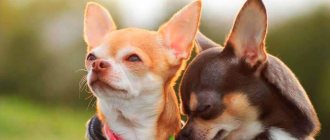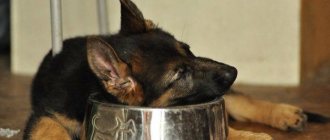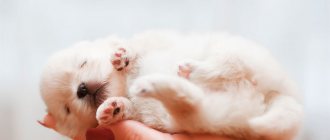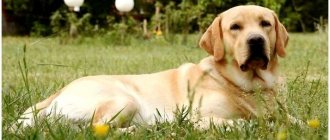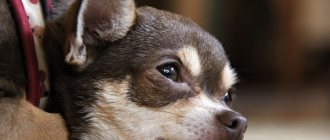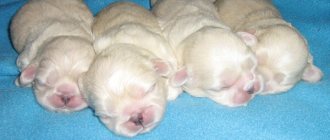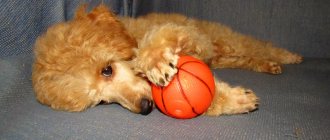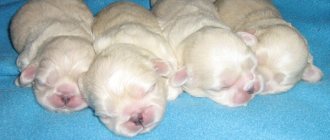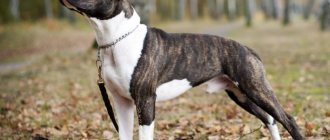Due to the fact that this breed has several varieties that differ from each other in growth, all Chihuahuas grow differently.
What should a Chihuahua puppy weigh, depending on his age, how many months will he grow up to, and how much will he weigh when he grows up? And what should you do if, despite seemingly good care and proper feeding, your Chihuahua is not gaining weight well?
What proportions should a dog have?
The Chihuahua is a very small dog. Its purity is evidenced by its appearance conforming to the following parameters:
- the body is compact, miniature and even lean. The muscles are clearly visible, the back is straight, the buttocks are rounded. The height of a male at the withers is 23 cm, that of a female is 18 cm;
- the head is shaped like an uneven circle, sometimes resembling an apple. There is a fontanel on the skull - a molera;
- the nose is slightly turned up;
- round, large eyes, often dark, but sometimes there are dogs with light eyes;
Long-haired and short-haired dogs
- the tail is curved in a semicircle and elongated. The tip of the tail always points towards the lower back if the dog is calm and not irritated by anything. In dogs when excited, the tail curls into a ring;
- limbs are strong, sinewy;
- The ears are large, elongated, always erect. The tips of the ears are rounded;
- There are long-haired and short-haired dogs. The short-haired representatives of the breed have a soft, shiny coat. Long-haired dogs have a beautiful collar on the chest and bloomers on the paws. The tip of the tail is fluffy. The fur is straight;
- The most common dogs are speckled, chocolate, red or spotted. The coat color does not affect the purity of the breed; it can be anything.
Note! Chihuahuas are playful, very active, and it is not easy to keep up with them, so the dog should not be let off the leash if the owner does not have the proper degree of mobility. As an option, you can teach the dog special commands, that it needs to constantly return to the person. They learn quickly. It's easy for a small dog to get lost in a crowd.
Different coat colors
Head
The Chihuahua's skull is very large, apple-shaped, the width and height of which are equal. The voluminous forehead has pronounced eyebrows.
Due to the convexity of the forehead, the transition to the muzzle is clearly visible.
The mini dog's muzzle, wide towards the base, tapers towards the nose. A short muzzle with poorly defined cheekbones has rounded, tightly fitting lips, the dry and tense structure of which should completely cover the teeth.
The small nose may be slightly turned up. The standard allows any color of the nose that matches the coat color.
The large, round eyes of the Chihuahua have an expressive, slightly sly look. Widely spaced ocelli suggest the presence of a deep furrow between them. They should not be too convex. The eye color is dark, matching the coat color, although the standard allows for a light color.
If you look at a Chihuahua from the front, then according to the standard, the eyes and nose of a mini dog form an equilateral triangle.
The standard allows for both scissor and level bites. But an undershot or vice versa - an undershot is already considered a defect. The set of teeth may not be complete - they do not attach much importance to this.
The animal's large ears are set high, wider at the base, tapering to a rounded tip. When the dog is calm, they hang at an angle of forty-five degrees, and when excited they take a vertical position and become closer to each other.
The neck is set high and has a slight bend at the top, without dewlap. In males it is more powerful.
To what age do representatives of the breed grow?
Kitten weight by month: correct ratio table
The puppy's weight and height change rapidly during the first month of life. Every day the weight doubles. But you can understand what size a dog will be only after it is 1 year old. By this time, most puppies reach the weight and height of an adult dog. But they don't stop growing. A dog's body stops changing by the age of 1.5 years.
Important! A dog is considered an adult when it reaches 1 year of age. But even after that it grows for another six months, most often in width.
Gradually, the formed fat layer will disappear, and the dog will become lean. Naturally, if the owner takes care that he eats properly. If your dog eats well, exercises a lot, but is still too fat, you should contact your veterinarian.
Weight statistics
If the breeder says that there will be a mini and names a specific weight in adulthood, ask his current weight and age and try to make an approximate forecast yourself in comparison with medium-sized puppies. Your assessment may turn out to be much more truthful than the assessment of the owner interested in selling. Here are approximate statistics based on the weight of puppies from our kennel: 2 months minik - 250-700 gr. average - 900- 1300
3 months mini-400-900 average 1300-1500
At the age of four months, it is desirable that the minik’s weight does not go much beyond the limit of 1 kilogram.
If you are told that a puppy weighs 900-1200 grams at 3 months, then keep in mind that it is one and a half kg. it most likely will not weigh. And there will be 2000-2400 (and this is also a small specimen).
Coat
There are two types of Chihuahua fur:
- short;
- long.
The short-haired coat fits tightly to the dog's body and has smooth and soft hairs of a straight structure. If there is undercoat, the length of his hair will be slightly longer, as well as on the neck and tail. On the head and ears the hair is the shortest, in the throat area it is practically absent.
The long-haired coat has thin and soft hairs of an even structure. Light waves are allowed, but not curly hair. Longer hair is found in the following places: ears, neck, paws, tail, chest. The dog's body should not be covered with too long and thick hair.
What determines the size and weight of a Chihuahua?
Alabai: weight of an adult dog and puppy by month
The size and weight of the dog depend on the following factors:
- the puppy belongs to one of 3 varieties - lines found in the breed. It is genetic characteristics that determine the size of a dog. So, some puppies grow up to be massive, while others, even by the standards of their breed, remain miniature. Height and weight are affected by various genetic diseases. If the puppy is not growing, you need to show it to the veterinarian;
- time of mating and estrus. If a dog takes a walk ahead of schedule, it may stop growing and not reach the standard height and weight requirements for the breed;
- the quality of life. The puppy must be fed in accordance with the requirements of its age and breed. It is impossible to underfeed or overfeed a dog in order to obtain an ideal-sized pet. Puppies that are underfed at an early age, upon reaching adulthood, indeed remain very small, but they often develop vitamin deficiency and chronic diseases of internal organs and limbs;
- physical activity. The dog is very active, but there are puppies that are not prone to long runs. They often get fat and are usually lower at the withers than other representatives of the breed.
Note! A dog’s weight is also related to the parameters that were inherent to him from birth. If a newborn puppy weighed no more than 80 g, then there is a high probability that an adult will weigh very little - 1.5-2 kg. A puppy born weighing 150-170 g can weigh up to 3 kg when it reaches one year. A special table helps determine the exact weight of the puppy.
Mini and standard sizes
What is the difference between a mini Chihuahua and a standard one?
The official breed standard does not mention a separate category of miniature dogs. The classification arose thanks to breeders who called:
- pets less than 1000 gr. - “mini”;
- dogs weighing 500 grams. - “supermini”.
The difference between both representatives is their size and weight. According to other parameters (skull shape, body proportions, color), they are a complete copy of each other. The character of the two animals is similar.
Important! Their miniature size does not allow females to perform their main reproductive function. Bearing and childbirth can be fatal for them.
Factors influencing growth
Development, weight gain, growth of Chihuahua puppies depends on these factors:
- Genetic predisposition. When purchasing a puppy, experienced owners carefully study the kitten's ancestors. Pathology, a developmental disorder that is “old” even about 5 generations ago may well manifest itself in a distant heir. It is genetics that is primarily responsible for the size, weight, speed of development of the animal, and the onset of the first heat in female puppies.
- Number of brothers and sisters. The more numerous the litter, the smaller its representatives will be. But this statement is not 100% valid. With proper care, nutritious and high-quality nutrition, even the weakest and frailest kitten can catch up, or even surpass its brothers in development.
- Care and feeding. In order for a Chihuahua baby to fully develop, he needs to create special development conditions - a cozy and calm environment, sufficient physical activity, good nutrition, vitamin and mineral supplements. The owner must keep a diary of his pet’s weight gain: in the first month he fills it out every week, in the 2-12th month – monthly. During the active period of development (3-9 months), the baby should gain at least 80-100 g monthly.
Health
You should immediately understand that the show career for such puppies is closed (for dogs less than 1700 g). Therefore, you can safely not pay special attention to the type of bite and number of teeth when purchasing. Very often, small sneezes have an abnormally large spring on the head; this may be one of the causes of hydrocephalus in a puppy. Although, from our experience, I can say that if a puppy with a large spring (molera) survives and feels fine until 3-5 months, then most likely there will be no further problems. Ask the breeder about the size of the spring and the behavior of the puppy. If the puppy is active enough and does not react to changes in the weather, this is a very good sign. If the puppy sleeps all the time and shows little activity, constantly trembles, whines, this is a bad sign. But you should also take into account that small puppies develop much more slowly than their medium-sized counterparts, so do not be surprised that littermates are already running around the apartment at full speed, and minis are mostly located next to their mother on the lounger (although it happens the other way around).
What is the table for?
Pregnancy of a Chihuahua by day and childbirth in a dog
A puppy height and weight gain chart is essential for all owners of small Chihuahuas. It helps to find out about existing problems in a timely manner, understand whether the dog is developing correctly, and, if necessary, contact a veterinarian.
The table contains important data about the weight and height of the pet in each month of its life. If your dog quickly gained weight and then suddenly lost weight, do not panic; you can always compare real data and information from the table. Sometimes losing weight or gaining weight at certain times in a puppy's life is normal. A small dog doesn't move much, so it gains weight better. Having learned to stand on his feet normally, and then to run, the puppy quickly gets rid of extra pounds.
Official data helps the breeder decide which category the puppy belongs to, whether it belongs to:
- standard line (adults weigh from 2.3 to 3 kg);
- small standard (1.8-2.3 kg);
- mini dogs (1.5-1.8 kg);
- super miri line (0.5-1.5 kg).
If there is a need, then, based on the data obtained, they try to correct the puppy’s weight (feed more or less, walk more often).
The puppy’s weight needs to be monitored using a special table.
How much does a Chihuahua puppy weigh by month?
The physical condition of a sneeze should be monitored not only weekly, but also monthly. The data will show what is happening to the puppy. The owner can track periods of slower weight gain and compare them with the average Chihuahua weight data by month presented in the table:
| Age | Weight (g) | |||
| 72-78 g | 79-120 g | 121-145 g | 146-170 g | |
| At 1 month | 210-240 g | 260-380 g | 460-490 g | 550-660 g |
| At 2 months | 310-380 g | 450-615 g | 685-770 g | 830-1045 g |
| At 3 months | 430-550 g | 630-860 g | 950-1055 g | 1170-1410 g |
| At 4 months | 560-720 g | 860-1120 g | 1260-1395 g | 1540-1820 |
| At 5 months | 675-860 g | 990-1310 g | 1475-1655 g | 1820-2145 |
| At 6 months | 750-950 g | 1115-1445 g | 1650-1850 g | 2020-2415 |
| At 7 months | 860-1040 g | 1230-1660 g | 1815-2050 | 2220-2665 g |
| At 8 months | 970-1130 g | 1335-1510 g | 2110-2240 g | 2420-2925 g |
| At 9 months | 1010-1210 g | 1410-1870 | 1710-2310 g | 2510-3010 g |
| At 10 months | 1010-1210 g | 1410-1900 g | 1710—2310 g | 2510-3010 g |
| At 11 months | 1010-1210 g | 1410-1900 g | 1710—2310 g | 2510-3010 g |
| At 12 months | 1010-1210 g | 1410-1900 g | 1710—2310 g | 2510-3010 g |
Large discrepancies with the indicators are a reason to contact a veterinarian.
Mini
Mini Chihuahuas are born not only to the youngest parents. More often they appear as a result of mating of standard individuals. This applies to both short-haired and long-haired Chihuahuas. At birth, the baby weighs about 100 g. In a month, he triples his weight, and by six months he reaches 1200 g. The height at the withers of the minik during this period is 15 cm.
Standard
According to the FCI and RKF standard, a Chihuahua should weigh from 1.5 kg to 3 kg. There are no strict restrictions on height at the withers; approximate values are 12-21 cm. If a dog is more than 3 kg, this is recognized as a defect that allows it to be disqualified from exhibitions or competitions.
Table of dog weight and height at the withers
Chihuahua dog weight chart by month is an important tool that all Chihuahua breeders use.
| Age, month | Weight according to line, g | |||||||
| Super mini | Height, cm | Mini | Height, cm | Small standard | Height, cm | Standard | Height, cm | |
| Newborn | 70-80 | 14-15 | 90-120 | 14-17 | 125-130 | 17-19 | 145-170 | 18-23 |
| 1 | 200-225 | 230-350 | 450-490 | 500-650 | ||||
| 2 | 315-370 | 455-610 | 680-765 | 825-1050 | ||||
| 3 | 425-540 | 625-855 | 940-1050 | 1165-1400 | ||||
| 4 | 570-710 | 855-1110 | 1250-1390 | 1530-1820 | ||||
| 5 | 680-885 | 995-1300 | 1480-1645 | 1815-2150 | ||||
| 6 | 740-945 | 1110-1450 | 1645-1845 | 2015-2410 | ||||
| 6,5 | 765-970 | 1150-1510 | 1710-1900 | 2100-2500 | ||||
| 12 | 1000-1200 | 1400-1900 | 2100-2300 | 2500-3000 |
For your information! To determine the weight of a dog, a three-month-old puppy can be weighed and the result obtained multiplied by 2. These will be the parameters of an adult.
How to use the table
Every 30 days the puppy is weighed and measured at the withers. If its parameters fall significantly short of the specified standard, contact a specialist. There is no reason to appeal if the parameters deviate by a few grams down or up.
Mini individuals
The weight of a mini Chihuahua is approximately 1.5 kg. The height at the withers is about 14-16 cm. At the same time, the breed standard does not indicate the varieties, they simply do not exist; the parameter for classifying dogs by height and weight was introduced by breeders for convenience.
Minis have the same playful character as most larger representatives of the breed. They are affectionate and sociable, but need firm guidance from their owner. Otherwise, dogs grow up to be aggressive, cowardly and hysterical.
Minis are not included in the standard
RKF breed standard with explanation
The Chihuahua standards of the Russian and International Cynological Federations do not have any fundamental differences.
The breed is classified:
- group 9 (companion dogs),
- section 6 (Chihuahueño),
- no working class
The Hichuahua is a tightly built and at the same time elegant dog, nimble, lively, a typical fidget with a hapless expression on its face.
Chihuahuas are generally absolutely fearless and have incredible reflexes.
Weight
The allowed difference is from 500 g to 3 kg. Ideal figures range from 1.5 to 1.8 kg. Individuals heavier than 3 kg will be disqualified.
Height
To evaluate dogs of this breed, the criterion is only the weight of the individual; height at the withers is not a criterion when evaluating an individual of this breed. The standard does not specify strict limits for growth.
The distance from the ground to the withers should be slightly less than the length of the body. The square format for males is the most preferred. For bitches, a more extended format is possible. According to the latest changes to the standard, the stretch index cannot exceed 110.
Head
Consists of two departments:
Cranial.
The apple-shaped skull is well rounded. A parietal fontanel is possible, but it is more advantageous when it is not there. The forehead is strongly highlighted.
The front is divided into parts.
- Muzzle, dry, compressed. When looking at it from the side, it is straight, and closer to the nose it is pointed and raised upward.
- Cheekbones, clear lines.
- The eyes are slightly convex, large and almost round, brownish or black in color. Dark iris is more preferable.
- Teeth and jaws. Skew, undershot and other deformations associated with the animal’s bite are not allowed. A straight or scissor jaw position is considered normal.
- The ears are somewhat reminiscent of a cat's. They do not hang, the auricle is open. Ideally, they form an almost isosceles triangle. When at rest, they are slightly lowered towards the temples, forming an angle of 45 degrees.
To read: Varieties of hairless dog breeds, description of their external characteristics
The lack of a row of teeth is considered a flaw, but not critical. They will not be disqualified because of it.
Frame
The breed standard specifies the ideal properties and proportions of each part of the body.
The neck is not short, with tight-fitting skin. The scruff is slightly pronounced. For long-haired Chihuahuas, a lush “mane” is a must. The thickness of the neck may vary depending on the sex of the individual. Body:
- Top line and withers. The back is parallel to the floor with a slight elevation at the withers.
- The back is not wide, but quite dense.
- The lower back, the muscles are clearly defined.
- The croup is wider than that of many representatives of miniature breeds. Both flat and slightly inclined are allowed.
- The chest, the rib cage is quite wide, round in shape. Gives the impression of being massive. Barrel-shaped breasts are not acceptable.
- The bottom line, the toned shape is emphasized by clear lines.
- The tail is set high. Smooth, pointed towards the end. Pointed upward with a slight curve. Length equal to half the length of the back. The coat corresponds to the body. Long-haired Chihuahuas have a longer tail that is usually curled and resembles a headdress.
Limbs
The forelegs, when positioned correctly, are straight and level, regardless of the angle. Can't be called short. The shoulders have visible muscles. The breed is always distinguished by the distinct angles of the shoulder blades and forearms. Elbows fit tightly to the body. The paws are not large. The standard does not recognize the similarity of paws to those of a cat or a hare. The fingers should be well apart. The nails are quite convex.
The hind legs have strong muscles and pronounced angles of the hip, knee and hock joints. The hock joint is equal in length to the elbow joint. The Achilles tendon is well developed. When viewed from the rear, the paws are well apart.
Movements
The Chihuahua walks like a leader. The steps are wide and the lunge is strong, with a powerful push. The gait is free and slightly springy. The hind legs follow exactly behind the front legs. The head is raised and looks strictly in the direction of movement. The back is straight and strong.
The leading distinctive feature of a purebred individual is the habit of holding its tail. When moving, the Chihuahua keeps it pointed upward or bent in a semicircle.
Coat
The skin is delicate, thin and elastic in any area of the body.
Chihuahuas have several coat variations:
- Smooth-haired. The hair is short and lies close to the body. Rarely are individuals born with undercoat, in which case the length of the coat is slightly longer. A mandatory rule is the softness and shine of the wool. Hairless dogs are disqualified.
- Long-haired. The hair is longer and the coat is silkier. Slightly wavy, but better smooth. The fur is long in the area of the ears, on the back near the withers, on the hind legs (forming panties) and on the tail. Individuals with excessively long or curly hair are not allowed.
To read: Rescue dog Moscow diver: characteristics of the breed
Long-haired Chihuahuas cannot have short-haired puppies, but smooth-haired ones can have both.
Color
There are many varieties of Chihuahua colors. There are no restrictions in the standard for both smooth-haired and long-haired dogs.
The breed has about 70 types of colors. But there are only a few of the most common:
- Red (Red): completely red or red with white markings,
- Golden fawn: looks like a less rich red or cream,
- Black and Tan: The base tone is black, but fades to a lighter tone on the limbs or other parts of the dog's body.
- Spotted: Most often medium-sized spots on a white coat.
The following colors are less common and are considered uncharacteristic for this breed:
- white,
- black,
- chocolate,
- brindle,
- blue.
<,>,
How puppies grow
From birth to 10 months, a Chihuahua gains 30-60 g of weight every week. Closer to a year, the puppy begins to grow more actively, he eats more, so he can gain 120-150 g weekly. Sometimes dramatic changes in weight are observed already in six-month-old individuals.
Important! The puppy's weight and body size increase sharply. Up to 1.5 years this is not a deviation. The dog is still growing. If after the specified time the dog continues to change, becoming higher at the withers, then most likely he is not a purebred Chihuahua.
The weight of the Chihuahua is determined after weighing, be sure to compare the data obtained with a table of basic parameters. If the puppy was born very small, but is viable, eats well and is growing in size, there is no cause for concern. In the first four weeks of life, a Chihuahua weighs from 200 to 450 g, this difference is considered normal.
When determining the weight of six-month and one-year-old dogs, the availability of nutritious food and an active lifestyle are taken into account. If your dog eats frequently and doesn't look thin, but is very small, smaller than other toy breeds, you can take him to the vet. But there are dogs that weigh no more than 1 kg per year, while the weight of adult Chihuahuas of the same breed reaches 2.5 and 3 kg.
What to do if your Chihuahua is underweight?
Not all Chihuahua puppies exhibit the same growth rate shown in the chart above. Some grow slower than others - and that's okay. However, if your Chihuahua is consistently weighing less than he should, you should take steps to ensure that there is no underlying disease or problem.
First, make sure you are feeding your puppy "puppy" dog food. It has a higher caloric content to meet the growth needs of puppies. If your puppy is still nursing, make sure his littermates don't restrict his access.
You should also ask your veterinarian to give your puppy a physical exam when he gets his first vaccination (around 5-6 weeks). During this visit, your veterinarian can check to see if your Chihuahua puppy is suffering from parasites, malnutrition, or other problems that may be slowing his growth.
Ideal case
The body of this breed must be harmoniously and firmly built. A slight elongation is not considered a defect. The back is strong and level. It goes into the muscular lower back. The croup itself is wide with a slight slope. The chest is quite wide with rounded ribs. The chest itself is also rounded to the elbow of the front legs, forming a characteristic barrel-shaped shape with a tucked belly.
There are two types of housing:
- dir – elegant or “deer-like”;
- cobby - heavy.
The tail of all Chihuahuas is of average length and is set high. It is thick at the base, tapering towards the apex. A Chihuahua without a tail is considered a defect.
General form
The Chihuahua is the smallest dog in the world. This mini breed has an elegant appearance and a compact body structure: the height at the withers is proportional to the weight of the animal. She always proudly and high holds her medium-length tail, curled into a half ring. The tail should always be directed towards the straight line of the lower back.
The structure of the mini dog’s skull has a striking distinctive feature that is not inherent in other breeds: a small gap is formed between its bones, called a fontanel, which almost never closes.
Chihuahua clothing size
Before buying clothes for a dog, measure:
- length of the back from the base of the tail to the withers;
- neck girth;
- chest girth.
Most often, Chihuahuas choose clothes in the following sizes:
- XS. This is the smallest size, suitable for dogs with a back length of 15 to 20 cm, a chest girth of up to 28 cm, and a neck girth of 12 to 20 cm. Clothes of this size are sewn for puppies and mini Chihuahuas that weigh up to 1.2 kg;
- S. If a dog has a back length of 21-24 cm, a chest of no more than 35 cm in girth, and a neck of no more than 23 cm, then clothes marked S are suitable for it. Various overalls and blouses of this size are sewn on mini Chihuahuas weighing on average up to 2.3 kg;
- M. Clothes of this size are worn by standard individuals with a back length of up to 28 cm, chest girth of up to 46 cm and neck girth of up to 31 cm.
Note! Some dogs buy clothes in size L. This is necessary if the dog weighs more than 3 kg and has a back length of up to 33 cm. To determine the size, use the Chihuahua growth chart.
Agreement
Of course, some breeders say that they enter into an agreement. And it works magically on some clients! In the vast majority of contracts, contracts are drawn up in such a way that they protect the interests of the breeder and not the buyer. The value of such a contract for the buyer is zero. If you buy a mini Chihuahua and are offered a contract as a weight guarantee, make sure that the contract includes a clause for a full refund or other penalties for the breeder if his projected adult size is too large.
Ask your seller if he is ready to record his unfounded guarantees in the contract? And is he ready to return 100% of the puppy’s cost back if his forecast does not come true in, say, a year and a half? It’s one thing to promise, but another thing to bear financial responsibility for your words...
I have not seen a single agreement in which the breeder imposes any fines or refunds in case of violation of its promises. I know of only 1 case, based on a client’s story, that there was a partial refund under the contract (but this is most likely an exception to the rule).
In most cases, the contract does not provide any advantages when purchasing a puppy. No breeder will guarantee the future health of a puppy (and this is the most important thing). If the breeder wants to deceive you with the weight, then in such an agreement there will simply be no guarantees regarding weight. As for the breed, virtually nothing can be guaranteed here either. What exactly a dog will be like as an adult and it is very difficult to predict whether it will have breed defects.
The Apirina Mexicano nursery does not guarantee exact weight. I tell you the puppy's weight, information about the parents and the estimated, but not the exact weight.
Limbs
Steady and strong front legs form a straight line with the elbows and are parallel to each other. When viewed from the side, you can see that the pastern is elastic and slightly oblique. The elbows are tightly pressed to the body.
Well developed hind legs are set vertically and are also parallel to each other, with a good angle of the hock joints. Narrow posture or weakness in the limbs are considered a defect.
The limbs have soft paw pads and long fingers with slightly elongated claws. Pay attention to how many fingers the puppy has. Dewclaws need to be removed.
Deviations from the norm
Deviations from the breed norm are common. But all of them are mostly associated with the genetic characteristics of a particular puppy or with improper care for it by the owners. So, if a dog is underfed, starting from birth, then it grows even smaller than it should be. You shouldn't overfeed your Chihuahua either; they love to eat and never refuse extra food in their bowl. If the dog does not move enough, there is a risk of developing obesity, which will have to be combated using medical methods.
A deviation is considered to be too much growth of the dog. 24-25 cm at the withers is almost the limit for a male. Females are even smaller. Chihuahuas, whose growth was small from birth, usually do not reach the standard parameters, always maintaining a minimum body weight.
Basics of the standard
The main parameters included in the breed standard:
- general form;
- proportions;
- character;
- head;
- frame;
- limbs;
- movements;
- wool cover;
- color;
- dimensions;
- flaws;
- vices.
How many months do these mini dogs grow is of interest to many potential buyers. Basic skeletal development continues for up to six months, after which the dog's growth slows down. Until twelve months, mainly the skull and chest begin to develop. Thus, the height of an adult animal can be determined already at the age of six months.
Flaws
Any deviation from the standard parameters is considered a serious deficiency. These include the following points:
- narrow skull;
- flat skull;
- small eye size;
- large protrusion of the eyes;
- long muzzle length;
- pointed ears;
- completely drooping ears;
- small neck;
- curved or concave spine;
- strongly sloping croup;
- long body length;
- barrel-shaped ribs;
- narrow set of front paws;
- elbows extending far away from the body;
- short or crooked legs;
- small breasts;
- displacement of the cup in the knees;
- jaw displacement;
- a short or completely curled ponytail with an incorrect fit;
- completely thin hairline;
- extra teeth;
- unexpressed stop.
Comparison of Chihuahua sizes with other dwarf breeds
The Chihuahua is truly the smallest dog in the world. For comparison, other dwarf breeds both in weight and size greatly exceed this small, almost pocket dog.
Yorkies are the second most popular after Chihuahuas.
- Yorkshire Terrier. Weighs up to 3 kg, at the withers reaches a height of 23 cm. This almost corresponds to the standard size of a Chihuahua.
- Pomeranian Spitz. An adult weighs up to 3.2 kg with a height of 18 to 30 cm at the withers.
- Maltese. A dwarf dog of this breed can weigh 3-4 kg with a height of no more than 25 cm.
- Brussels Griffon. Weighs up to 6 kg with a height of only 25-30 cm.
- King Charles Spaniel. Weighs more than 6 kg with a height of just over 30 cm at the withers.
- Pug. A small dog that sometimes weighs over 8 kg. Her height is 25-35 cm.
Chihuahuas are closest in parameters to the Yorkshire Terrier and Pomeranian Spitz.
Dog breeders all over the world happily breed Chihuahuas. This small dog thrives in limited living space, weighs and takes up very little space, is cheerful and friendly. When choosing a pet, pay special attention to the weight and size of the puppy. If the future owner does not know what parameters a purebred dog must meet, it is better to check the weight and size table, and also make a deal to purchase a puppy after examining it by a veterinarian. The specialist will tell you how much a Chihuahua weighs at a certain age, what to feed and how to care for the dog.
From the history of the breed
The first mentions of the breed go back thousands of years. There are a great many hypotheses about the origin of the breed and the mysteries associated with it. The origin of this tiny creature is shrouded in an incredible number of legends - right up to its alien homeland.
Small figurines, rock and other images of a small dog similar to a modern Chihuahua, mummified bodies of a miniature dog, are found during excavations of ancient structures throughout Mexico. The dog was kept as a sacred animal in the houses of the nobility and priesthood of the Mayan, Aztec, and Toltec tribes. The name of the small pet was Techichi.
With the arrival of the conquistadors and the fall of ancient civilizations, the little Techichi were forced to flee, to hide from humans. The wildest situation - the Spaniards enjoyed feasting on tender dog meat.
Since then, the dogs have gone into the forests and avoided human contact. However, almost three centuries later, European tourists visiting Mexico began to bring home tiny large-headed dogs purchased from the local population. This is how Chihuahuas came to Europe.
Vices
The following defects are considered defects for which you can get disqualified:
- too light build;
- heavy weight, more than three kilograms;
- lack of a ponytail;
- parts of the tail or ears have been removed;
- bald patches on the skin;
- body too long;
- in males - absence of testicles, undeveloped or not fully descended testes into the scrotum.
Tell me, does your Chihuahua fit the standard parameters? How old is your little dog?
Defects that are a breed defect and a reason for disqualification
The IFF and RKF indicate a list of main defects that indicate the deviation of representatives of the breed from the norm and prohibit participation in exhibitions and breeding. It includes:
- deviations in behavior in the form of unmotivated aggression, excessive fearfulness;
- physical defects;
- cryptorchidism in males;
- atypical structure;
- open fontanel;
- drooping, short or cropped ears;
- malocclusion, jaw deformations;
- docked tail;
- baldness;
- non-standard type of coat (curly, patchy);
- marble color;
- non-compliance with weight standard.
